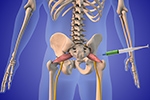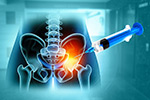As patients increasingly seek non-surgical alternatives for orthopedic conditions, Platelet-rich plasma (PRP) therapy has emerged as a promising treatment option. Dr. Benjamin Domb, founder of the American Hip Institute and a leading expert in both surgical and non-surgical hip procedures, has successfully incorporated PRP therapy into his comprehensive treatment approach for patients seeking natural healing solutions.
If you haven't read Part 1 of our series on Non-Surgical Orthopedic Treatments, which covers diagnostic cortisone injections, [CLICK HERE.]
What is PRP Therapy?
PRP therapy harnesses the body's natural healing capabilities by using the patient's own blood components. The process begins with a simple blood draw, similar to a routine laboratory test. This blood sample is then processed through a centrifuge, which separates the platelet-rich plasma from other blood components. The resulting concentrated platelet solution contains growth factors and proteins that play crucial roles in tissue repair and regeneration.
"PRP therapy represents a significant advancement in non-surgical orthopedic treatments," explains Dr. Domb. "By concentrating the healing components naturally present in a patient's blood, we can target specific areas of injury and potentially accelerate the healing process."
How Does PRP Work?
When injected into the affected area, the concentrated platelets release growth factors that stimulate and optimize the body's healing response. These growth factors can:
- Promote tissue repair and regeneration
- Reduce inflammation
- Stimulate collagen production
- Enhance blood flow to the injured area
The procedure typically takes less than an hour and is performed on an outpatient basis. Since PRP is derived from the patient's own blood, the risk of adverse reactions is minimal.
Applications in Orthopedic Care
At the American Hip Institute, Dr. Domb and his team utilize PRP therapy to treat various orthopedic conditions, including:
- Tendon injuries and tendinitis
- Joint inflammation and early arthritic conditions
- Muscle strains
- Ligament sprains
- Sports-related injuries
The treatment is particularly effective for chronic conditions that haven't responded well to conventional treatments like physical therapy or anti-inflammatory medications.
What to Expect During Treatment
During a PRP session, patients first undergo a standard blood draw. While the blood is being processed, the treatment area is cleaned and prepared. The concentrated PRP solution is then precisely injected into the affected area using ultrasound guidance when necessary to ensure accurate placement.
Recovery and Results
Most patients can return to their daily activities within 24-48 hours after treatment. While some may experience mild soreness at the injection site, this typically resolves quickly. Dr. Domb emphasizes that optimal results often require a series of treatments, and improvement may be gradual as the body's natural healing processes take effect.
"Patient response to PRP therapy can vary," notes Dr. Domb. "We typically see the best results when PRP is incorporated into a comprehensive treatment plan that may include physical therapy and appropriate activity modification."
Future of PRP in Orthopedic Care
As research continues and techniques evolve, PRP therapy remains at the forefront of non-surgical orthopedic treatments. The American Hip Institute, under Dr. Domb's leadership, continues to study and refine PRP protocols to optimize patient outcomes and expand its applications in orthopedic care.
For patients seeking non-surgical treatment options for orthopedic conditions, PRP therapy offers a promising solution that leverages the body's natural healing capabilities. To learn more about whether PRP therapy might be right for you, consult with Dr. Domb and the expert team at the American Hip Institute.
This is Part 2 of our four-part series on Non-Surgical Orthopedic Treatments. [CLICK HERE TO READ PART 1] about cortisone injections, and stay tuned for Part 3, where we'll explore bone marrow aspirate concentrate (BMAC).





